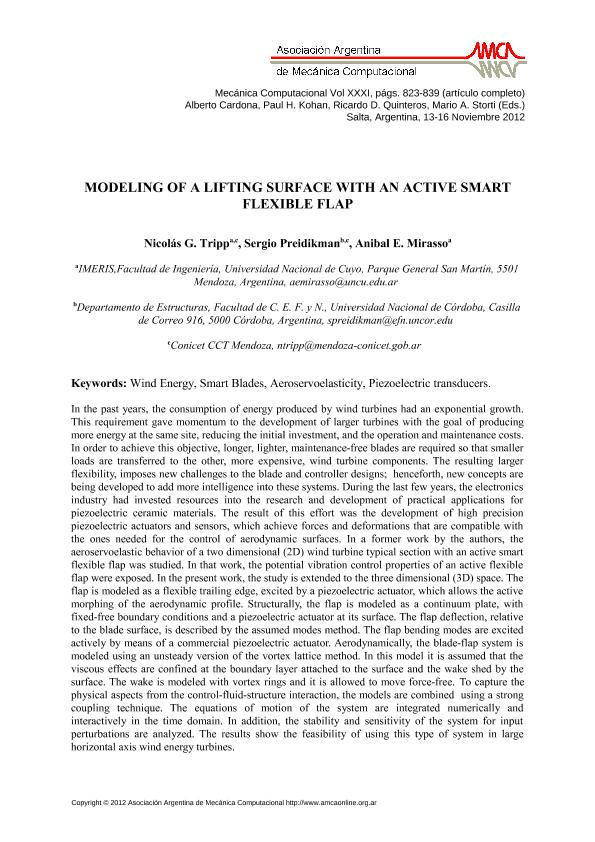Mostrar el registro sencillo del ítem
dc.contributor.author
Tripp, Nicolas Guillermo

dc.contributor.author
Preidikman, Sergio

dc.contributor.author
Mirasso, Anibal Edmundo

dc.date.available
2019-04-01T14:00:16Z
dc.date.issued
2012-11
dc.identifier.citation
Tripp, Nicolas Guillermo; Preidikman, Sergio; Mirasso, Anibal Edmundo; Modeling a lifting of a surface with an active smart flexible flap; Asociación Argentina de Mecánica Computacional; Mecánica Computacional; XXXI; 11-2012; 823-839
dc.identifier.issn
2591-3522
dc.identifier.uri
http://hdl.handle.net/11336/72893
dc.description.abstract
In the past years, the consumption of energy produced by wind turbines had an exponential growth. This requirement gave momentum to the development of larger turbines with the goal of producing more energy at the same site, reducing the initial investment, and the operation and maintenance costs. In order to achieve this objective, longer, lighter, maintenance-free blades are required so that smaller loads are transferred to the other, more expensive, wind turbine components. The resulting larger flexibility, imposes new challenges to the blade and controller designs; henceforth, new concepts are being developed to add more intelligence into these systems. During the last few years, the electronics industry had invested resources into the research and development of practical applications for piezoelectric ceramic materials. The result of this effort was the development of high precision piezoelectric actuators and sensors, which achieve forces and deformations that are compatible with the ones needed for the control of aerodynamic surfaces. In a former work by the authors, the aeroservoelastic behavior of a two dimensional (2D) wind turbine typical section with an active smart flexible flap was studied. In that work, the potential vibration control properties of an active flexible flap were exposed. In the present work, the study is extended to the three dimensional (3D) space. The flap is modeled as a flexible trailing edge, excited by a piezoelectric actuator, which allows the active morphing of the aerodynamic profile. Structurally, the flap is modeled as a continuum plate, with fixed-free boundary conditions and a piezoelectric actuator at its surface. The flap deflection, relative to the blade surface, is described by the assumed modes method. The flap bending modes are excited
actively by means of a commercial piezoelectric actuator. Aerodynamically, the blade-flap system is modeled using an unsteady version of the vortex lattice method. In this model it is assumed that the viscous effects are confined at the boundary layer attached to the surface and the wake shed by the surface. The wake is modeled with vortex rings and it is allowed to move force-free. To capture the physical aspects from the control-fluid-structure interaction, the models are combined using a strong coupling technique. The equations of motion of the system are integrated numerically and interactively in the time domain. In addition, the stability and sensitivity of the system for input perturbations are analyzed. The results show the feasibility of using this type of system in large horizontal axis wind energy turbines.
dc.format
application/pdf
dc.language.iso
eng
dc.publisher
Asociación Argentina de Mecánica Computacional
dc.rights
info:eu-repo/semantics/openAccess
dc.rights.uri
https://creativecommons.org/licenses/by-nc-sa/2.5/ar/
dc.subject
Wind Energy
dc.subject
Smart Blades
dc.subject
Aeroservoelasticity
dc.subject
Piezoelectric Transducers
dc.subject.classification
Ingeniería Mecánica

dc.subject.classification
Ingeniería Mecánica

dc.subject.classification
INGENIERÍAS Y TECNOLOGÍAS

dc.title
Modeling a lifting of a surface with an active smart flexible flap
dc.type
info:eu-repo/semantics/article
dc.type
info:ar-repo/semantics/artículo
dc.type
info:eu-repo/semantics/publishedVersion
dc.date.updated
2019-02-06T17:39:36Z
dc.journal.volume
XXXI
dc.journal.pagination
823-839
dc.journal.pais
Argentina

dc.journal.ciudad
Rosario
dc.description.fil
Fil: Tripp, Nicolas Guillermo. Consejo Nacional de Investigaciones Científicas y Técnicas. Centro Científico Tecnológico Conicet - Mendoza; Argentina. Universidad Nacional de Cuyo. Facultad de Ingeniería; Argentina
dc.description.fil
Fil: Preidikman, Sergio. Consejo Nacional de Investigaciones Científicas y Técnicas; Argentina. Universidad Nacional de Córdoba; Argentina
dc.description.fil
Fil: Mirasso, Anibal Edmundo. Universidad Nacional de Cuyo. Facultad de Ingeniería; Argentina
dc.journal.title
Mecánica Computacional

dc.relation.alternativeid
info:eu-repo/semantics/altIdentifier/url/https://cimec.org.ar/ojs/index.php/mc/article/view/4098
Archivos asociados
